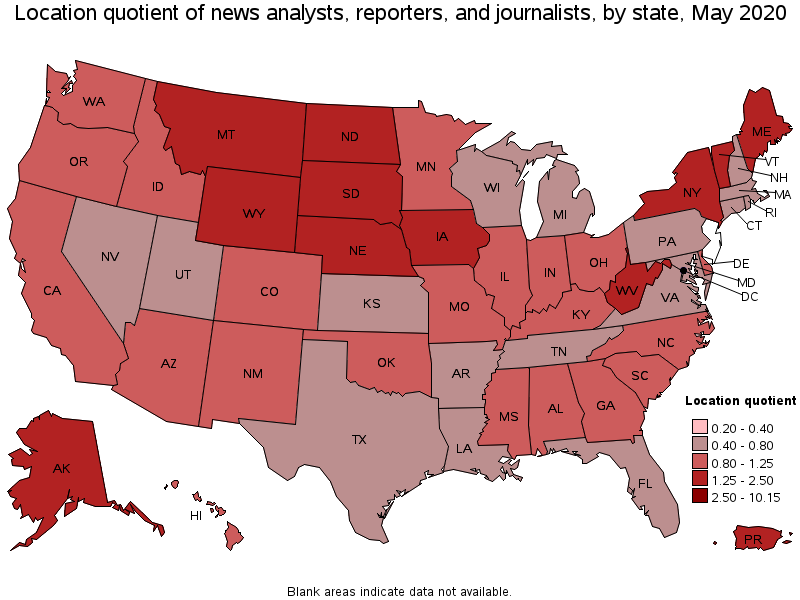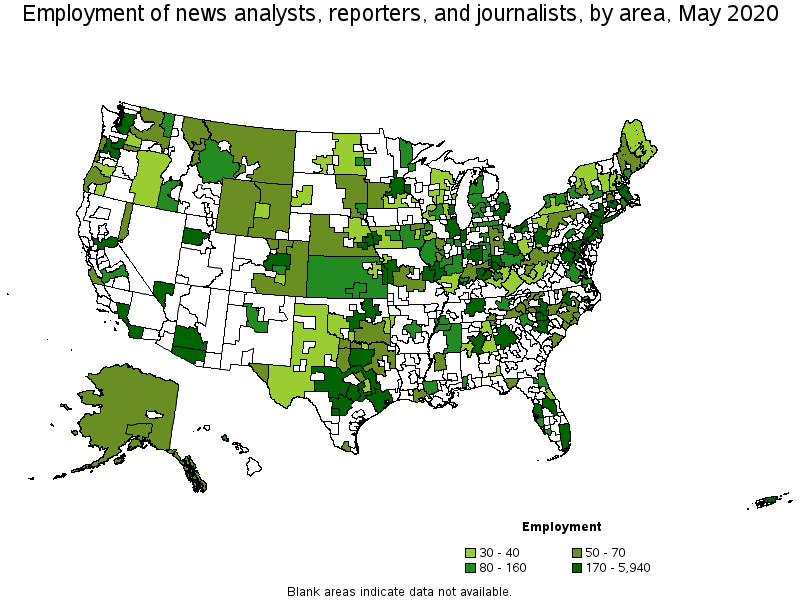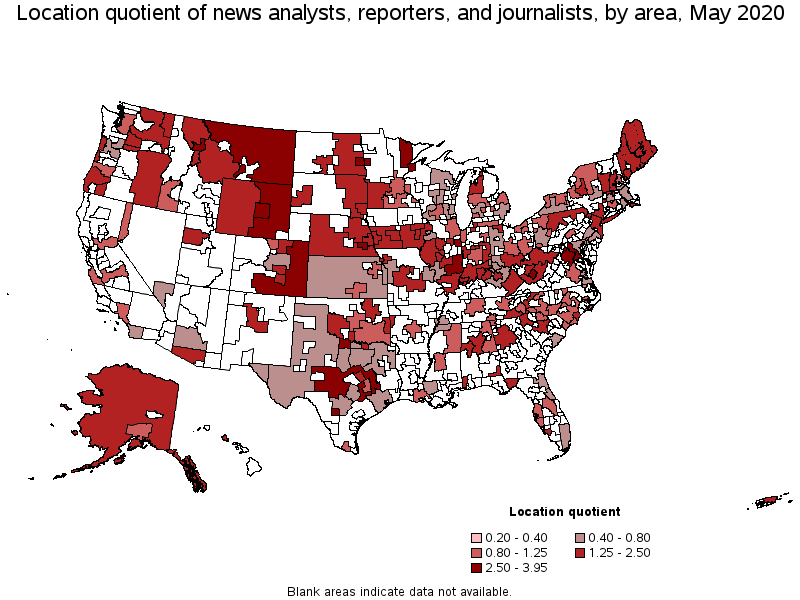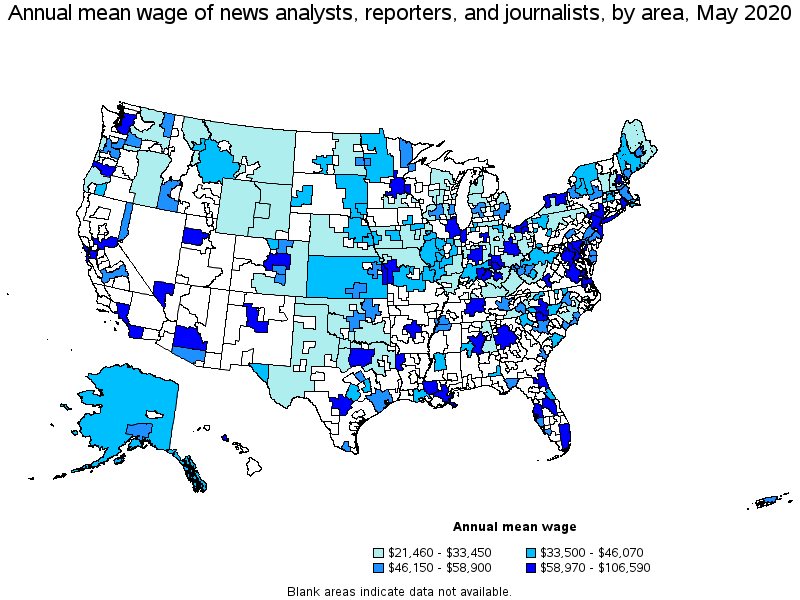An official website of the United States government
 United States Department of Labor
United States Department of Labor
Narrate or write news stories, reviews, or commentary for print, broadcast, or other communications media such as newspapers, magazines, radio, or television. May collect and analyze information through interview, investigation, or observation.
Employment estimate and mean wage estimates for News Analysts, Reporters, and Journalists:
| Employment (1) | Employment RSE (3) |
Mean hourly wage |
Mean annual wage (2) |
Wage RSE (3) |
|---|---|---|---|---|
| 41,580 | 3.7 % | $ 31.73 | $ 66,000 | 1.6 % |
Percentile wage estimates for News Analysts, Reporters, and Journalists:
| Percentile | 10% | 25% | 50% (Median) |
75% | 90% |
|---|---|---|---|---|---|
| Hourly Wage | $ 12.26 | $ 15.46 | $ 23.70 | $ 38.92 | $ 61.24 |
| Annual Wage (2) | $ 25,510 | $ 32,160 | $ 49,300 | $ 80,950 | $ 127,370 |
Industries with the highest published employment and wages for News Analysts, Reporters, and Journalists are provided. For a list of all industries with employment in News Analysts, Reporters, and Journalists, see the Create Customized Tables function.
Industries with the highest levels of employment in News Analysts, Reporters, and Journalists:
| Industry | Employment (1) | Percent of industry employment | Hourly mean wage | Annual mean wage (2) |
|---|---|---|---|---|
| Newspaper, Periodical, Book, and Directory Publishers | 16,890 | 6.17 | $ 25.68 | $ 53,410 |
| Radio and Television Broadcasting | 16,700 | 8.22 | $ 35.04 | $ 72,880 |
| Other Information Services | 4,850 | 1.40 | $ 36.73 | $ 76,400 |
| Motion Picture and Video Industries | 1,080 | 0.33 | (8) | (8) |
| Colleges, Universities, and Professional Schools | 640 | 0.02 | $ 28.13 | $ 58,510 |
Industries with the highest concentration of employment in News Analysts, Reporters, and Journalists:
| Industry | Employment (1) | Percent of industry employment | Hourly mean wage | Annual mean wage (2) |
|---|---|---|---|---|
| Radio and Television Broadcasting | 16,700 | 8.22 | $ 35.04 | $ 72,880 |
| Newspaper, Periodical, Book, and Directory Publishers | 16,890 | 6.17 | $ 25.68 | $ 53,410 |
| Other Information Services | 4,850 | 1.40 | $ 36.73 | $ 76,400 |
| Cable and Other Subscription Programming | 490 | 0.97 | (8) | (8) |
| Motion Picture and Video Industries | 1,080 | 0.33 | (8) | (8) |
Top paying industries for News Analysts, Reporters, and Journalists:
| Industry | Employment (1) | Percent of industry employment | Hourly mean wage | Annual mean wage (2) |
|---|---|---|---|---|
| Grantmaking and Giving Services | (8) | (8) | $ 54.07 | $ 112,470 |
| Telecommunications | (8) | (8) | $ 42.19 | $ 87,750 |
| Other Information Services | 4,850 | 1.40 | $ 36.73 | $ 76,400 |
| Radio and Television Broadcasting | 16,700 | 8.22 | $ 35.04 | $ 72,880 |
| Employment Services | 70 | (7) | $ 34.35 | $ 71,450 |
States and areas with the highest published employment, location quotients, and wages for News Analysts, Reporters, and Journalists are provided. For a list of all areas with employment in News Analysts, Reporters, and Journalists, see the Create Customized Tables function.

States with the highest employment level in News Analysts, Reporters, and Journalists:
| State | Employment (1) | Employment per thousand jobs | Location quotient (9) | Hourly mean wage | Annual mean wage (2) |
|---|---|---|---|---|---|
| New York | 5,790 | 0.67 | 2.23 | $ 43.48 | $ 90,450 |
| California | 4,100 | 0.25 | 0.83 | $ 35.57 | $ 73,990 |
| Texas | 2,420 | 0.20 | 0.67 | $ 27.50 | $ 57,210 |
| District of Columbia | 2,090 | 3.03 | 10.15 | $ 55.76 | $ 115,980 |
| Florida | 1,900 | 0.23 | 0.75 | $ 30.48 | $ 63,390 |

States with the highest concentration of jobs and location quotients in News Analysts, Reporters, and Journalists:
| State | Employment (1) | Employment per thousand jobs | Location quotient (9) | Hourly mean wage | Annual mean wage (2) |
|---|---|---|---|---|---|
| District of Columbia | 2,090 | 3.03 | 10.15 | $ 55.76 | $ 115,980 |
| Wyoming | 180 | 0.68 | 2.28 | $ 15.56 | $ 32,360 |
| Vermont | 190 | 0.67 | 2.25 | (8) | (8) |
| New York | 5,790 | 0.67 | 2.23 | $ 43.48 | $ 90,450 |
| Montana | 270 | 0.60 | 2.02 | $ 15.64 | $ 32,540 |

Top paying states for News Analysts, Reporters, and Journalists:
| State | Employment (1) | Employment per thousand jobs | Location quotient (9) | Hourly mean wage | Annual mean wage (2) |
|---|---|---|---|---|---|
| District of Columbia | 2,090 | 3.03 | 10.15 | $ 55.76 | $ 115,980 |
| New York | 5,790 | 0.67 | 2.23 | $ 43.48 | $ 90,450 |
| Georgia | 1,440 | 0.33 | 1.12 | $ 35.71 | $ 74,270 |
| California | 4,100 | 0.25 | 0.83 | $ 35.57 | $ 73,990 |
| Virginia | 830 | 0.22 | 0.75 | $ 32.28 | $ 67,140 |

Metropolitan areas with the highest employment level in News Analysts, Reporters, and Journalists:
| Metropolitan area | Employment (1) | Employment per thousand jobs | Location quotient (9) | Hourly mean wage | Annual mean wage (2) |
|---|---|---|---|---|---|
| New York-Newark-Jersey City, NY-NJ-PA | 5,940 | 0.67 | 2.25 | $ 44.32 | $ 92,190 |
| Washington-Arlington-Alexandria, DC-VA-MD-WV | 2,590 | 0.86 | 2.87 | $ 51.24 | $ 106,590 |
| Los Angeles-Long Beach-Anaheim, CA | 1,830 | 0.31 | 1.05 | $ 34.26 | $ 71,260 |
| Atlanta-Sandy Springs-Roswell, GA | 1,090 | 0.41 | 1.39 | $ 39.52 | $ 82,200 |
| Chicago-Naperville-Elgin, IL-IN-WI | 1,070 | 0.25 | 0.82 | $ 32.49 | $ 67,570 |
| Dallas-Fort Worth-Arlington, TX | 660 | 0.18 | 0.61 | $ 35.98 | $ 74,840 |
| Minneapolis-St. Paul-Bloomington, MN-WI | 600 | 0.32 | 1.08 | $ 36.60 | $ 76,140 |
| Philadelphia-Camden-Wilmington, PA-NJ-DE-MD | 530 | 0.20 | 0.66 | $ 26.72 | $ 55,570 |
| Boston-Cambridge-Nashua, MA-NH | 520 | 0.20 | 0.67 | $ 25.01 | $ 52,020 |
| Miami-Fort Lauderdale-West Palm Beach, FL | 500 | 0.20 | 0.67 | $ 35.21 | $ 73,240 |

Metropolitan areas with the highest concentration of jobs and location quotients in News Analysts, Reporters, and Journalists:
| Metropolitan area | Employment (1) | Employment per thousand jobs | Location quotient (9) | Hourly mean wage | Annual mean wage (2) |
|---|---|---|---|---|---|
| Lincoln, NE | 200 | 1.17 | 3.90 | (8) | (8) |
| Casper, WY | 40 | 1.07 | 3.58 | $ 12.75 | $ 26,510 |
| Beckley, WV | 40 | 1.06 | 3.54 | $ 20.46 | $ 42,550 |
| Fargo, ND-MN | 130 | 0.97 | 3.26 | $ 28.20 | $ 58,660 |
| Wichita Falls, TX | 50 | 0.92 | 3.08 | $ 14.73 | $ 30,640 |
| Washington-Arlington-Alexandria, DC-VA-MD-WV | 2,590 | 0.86 | 2.87 | $ 51.24 | $ 106,590 |
| Missoula, MT | 50 | 0.84 | 2.81 | $ 17.39 | $ 36,170 |
| Duluth, MN-WI | 90 | 0.76 | 2.53 | $ 24.48 | $ 50,920 |
| Pueblo, CO | 40 | 0.73 | 2.43 | $ 22.87 | $ 47,560 |
| Portland-South Portland, ME | 140 | 0.70 | 2.33 | $ 24.65 | $ 51,260 |

Top paying metropolitan areas for News Analysts, Reporters, and Journalists:
| Metropolitan area | Employment (1) | Employment per thousand jobs | Location quotient (9) | Hourly mean wage | Annual mean wage (2) |
|---|---|---|---|---|---|
| Washington-Arlington-Alexandria, DC-VA-MD-WV | 2,590 | 0.86 | 2.87 | $ 51.24 | $ 106,590 |
| New York-Newark-Jersey City, NY-NJ-PA | 5,940 | 0.67 | 2.25 | $ 44.32 | $ 92,190 |
| Denver-Aurora-Lakewood, CO | 320 | 0.22 | 0.73 | $ 42.10 | $ 87,570 |
| San Francisco-Oakland-Hayward, CA | (8) | (8) | (8) | $ 39.67 | $ 82,520 |
| Atlanta-Sandy Springs-Roswell, GA | 1,090 | 0.41 | 1.39 | $ 39.52 | $ 82,200 |
| Seattle-Tacoma-Bellevue, WA | 480 | 0.24 | 0.82 | $ 38.52 | $ 80,120 |
| Indianapolis-Carmel-Anderson, IN | 330 | 0.32 | 1.09 | $ 38.33 | $ 79,720 |
| San Diego-Carlsbad, CA | 330 | 0.24 | 0.79 | $ 38.20 | $ 79,450 |
| Cleveland-Elyria, OH | 330 | 0.34 | 1.13 | $ 38.12 | $ 79,290 |
| Minneapolis-St. Paul-Bloomington, MN-WI | 600 | 0.32 | 1.08 | $ 36.60 | $ 76,140 |
Nonmetropolitan areas with the highest employment in News Analysts, Reporters, and Journalists:
| Nonmetropolitan area | Employment (1) | Employment per thousand jobs | Location quotient (9) | Hourly mean wage | Annual mean wage (2) |
|---|---|---|---|---|---|
| Hill Country Region of Texas nonmetropolitan area | 170 | 0.88 | 2.94 | (8) | (8) |
| East Central Illinois nonmetropolitan area | 130 | 1.18 | 3.95 | $ 13.55 | $ 28,170 |
| West Central Illinois nonmetropolitan area | 100 | 0.63 | 2.12 | $ 18.80 | $ 39,100 |
| Southeast Iowa nonmetropolitan area | 100 | 0.49 | 1.63 | $ 14.83 | $ 30,850 |
| Kansas nonmetropolitan area | 90 | 0.24 | 0.79 | $ 16.65 | $ 34,640 |
Nonmetropolitan areas with the highest concentration of jobs and location quotients in News Analysts, Reporters, and Journalists:
| Nonmetropolitan area | Employment (1) | Employment per thousand jobs | Location quotient (9) | Hourly mean wage | Annual mean wage (2) |
|---|---|---|---|---|---|
| East Central Illinois nonmetropolitan area | 130 | 1.18 | 3.95 | $ 13.55 | $ 28,170 |
| Eastern Wyoming nonmetropolitan area | 70 | 0.90 | 3.03 | $ 15.60 | $ 32,440 |
| Hill Country Region of Texas nonmetropolitan area | 170 | 0.88 | 2.94 | (8) | (8) |
| East-Central Montana nonmetropolitan area | 50 | 0.84 | 2.82 | $ 12.36 | $ 25,710 |
| Eastern and Southern Colorado nonmetropolitan area | 50 | 0.81 | 2.71 | $ 12.78 | $ 26,590 |
Top paying nonmetropolitan areas for News Analysts, Reporters, and Journalists:
| Nonmetropolitan area | Employment (1) | Employment per thousand jobs | Location quotient (9) | Hourly mean wage | Annual mean wage (2) |
|---|---|---|---|---|---|
| Central New Hampshire nonmetropolitan area | 30 | 0.34 | 1.14 | $ 30.30 | $ 63,030 |
| Central Missouri nonmetropolitan area | 70 | 0.49 | 1.65 | $ 20.07 | $ 41,750 |
| Alaska nonmetropolitan area | 70 | 0.67 | 2.26 | $ 19.90 | $ 41,390 |
| Southwest Montana nonmetropolitan area | 90 | 0.64 | 2.15 | $ 19.14 | $ 39,820 |
| West Central Illinois nonmetropolitan area | 100 | 0.63 | 2.12 | $ 18.80 | $ 39,100 |
These estimates are calculated with data collected from employers in all industry sectors, all metropolitan and nonmetropolitan areas, and all states and the District of Columbia. The top employment and wage figures are provided above. The complete list is available in the downloadable XLS files.
The percentile wage estimate is the value of a wage below which a certain percent of workers fall. The median wage is the 50th percentile wage estimate—50 percent of workers earn less than the median and 50 percent of workers earn more than the median. More about percentile wages.
(1) Estimates for detailed occupations do not sum to the totals because the totals include occupations not shown separately. Estimates do not include self-employed workers.
(2) Annual wages have been calculated by multiplying the hourly mean wage by a "year-round, full-time" hours figure of 2,080 hours; for those occupations where there is not an hourly wage published, the annual wage has been directly calculated from the reported survey data.
(3) The relative standard error (RSE) is a measure of the reliability of a survey statistic. The smaller the relative standard error, the more precise the estimate.
(7) The value is less than .005 percent of industry employment.
(8) Estimate not released.
(9) The location quotient is the ratio of the area concentration of occupational employment to the national average concentration. A location quotient greater than one indicates the occupation has a higher share of employment than average, and a location quotient less than one indicates the occupation is less prevalent in the area than average.
Other OEWS estimates and related information:
May 2020 National Occupational Employment and Wage Estimates
May 2020 State Occupational Employment and Wage Estimates
May 2020 Metropolitan and Nonmetropolitan Area Occupational Employment and Wage Estimates
May 2020 National Industry-Specific Occupational Employment and Wage Estimates
Last Modified Date: March 31, 2021